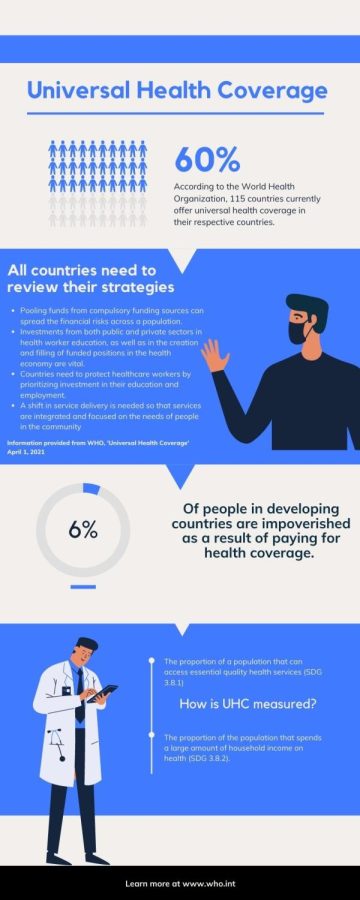Universal health coverage should be implemented in all countries
As countries begin to reevaluate their policies following the pandmeic, Universal Health Coverage (UHC) should be carefully considered for countries who have not already implemented it.
October 27, 2021
It seems like a no-brainer that healthcare should be provided to anyone who needs it. Now more than ever, we understand the effects of differing socioeconomic status and how that relates to access to healthcare. We have all either experienced first hand or heard about people who were in desperate need of treatment and weren’t able to get it due to insurance or financial reasons. At the end of the day, we are all equal and are all deserving of the best care. For that reason, the world should implement a system of universal health coverage (UHC); providing immediate and equal access to medical assistance for all.
As described by the World Health Organization (WHO), UHC allows citizens to access health services without incurring financial hardship. There have been several varying approaches to implementing UHC in countries across the world. In England, for example, they run on a single-payer system. This implies that the government funds free healthcare through the National Health Service (NHS), allowing all citizens to have equal access to government services. Likewise, in Canada, the system was implemented by the passing of federal legislation in 1957. The Canadian government is responsible for delivering health services and supervising its providers. 100% of Canada’s population is automatically covered through Medicare, which is government funded and administered by the specific provinces. Thus, ensuring life-long healthcare services for individuals.
Like any system, UHC has its pros and cons. The pros include lowering overall healthcare costs, allowing for equal treatment across the board and eliminating bankruptcy from medical costs. However, a few downfalls include people paying for others’ medical needs, a risk of people not being as careful due to a lack of financial incentive for staying healthy and potentially longer wait times for care.
According to The Commonwealth Fund, in the U.S. we spent 16.9% of the gross domestic product on health care alone in 2018, making us the highest spending country in the world. Although the U.S. does not currently offer UHC, the four primary methods of coverage include out of pocket payment, individual private insurance, employment based private insurance and government financing. To combat disparities even in just the U.S., we need to move to a globally based system to ensure equal access to services.
The primary concern with UHC is finding adequate and consistent funding for coverage. Having the entire community contribute money through the collection of taxes will lessen the burden on all socioeconomic classes. By doing so, this also decreases the risk of financial hardship down the road. These funds can also be used towards educating and organizing medical professionals in UHC to strengthen the overall coordination and execution of care.
As someone who has participated in a medical study abroad in another country, I have experienced healthcare disparities first hand. I watched as teenage girls gave birth to their children and were forced to walk back to the post-op room immediately after, due to lack of staff and equipment to allow them to be wheeled from the operating room. As a society, we need to do all that we can to prevent individuals from suffering due to lack of finances or insurances to get them proper medical care.
To learn more about UHC, visit WHO’s website to read more about the steps to attaining proper and accessible healthcare across the globe.

















